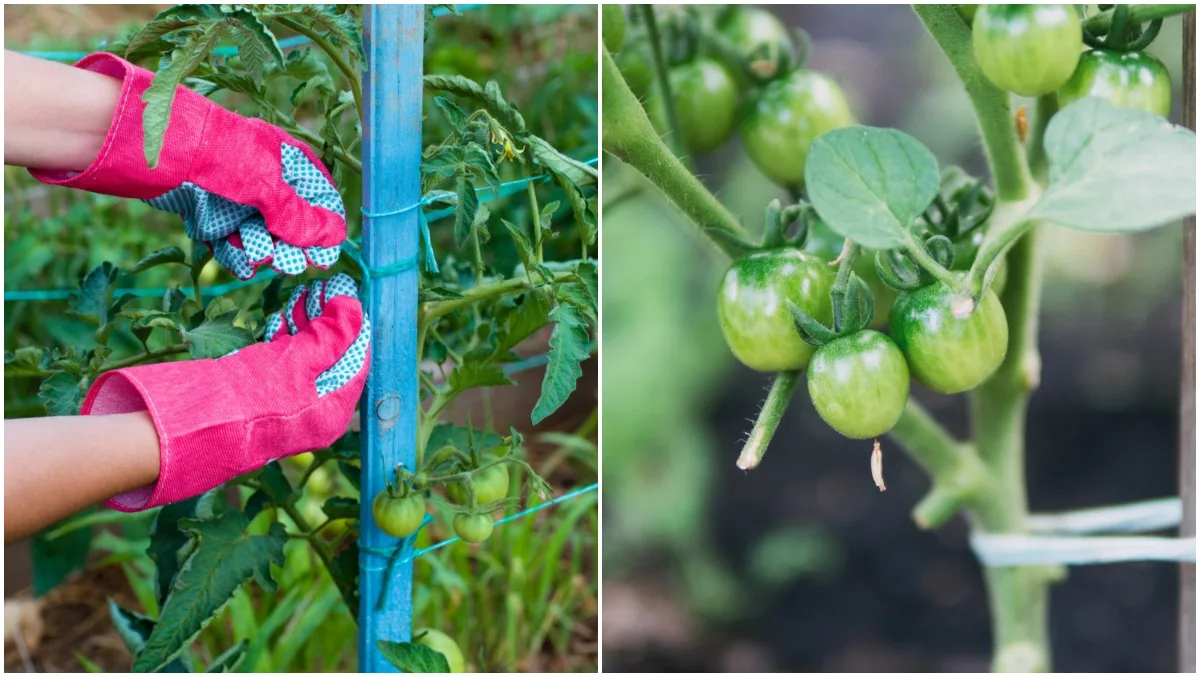
Tomatoes are not incredibly high-maintenance plants, but there are a few tasks you shouldn’t miss out on if you want to improve your harvest. One of those tasks is staking.
Tomatoes are staked for many reasons.
It keeps the fruit off the ground, stops the weight of the fruit from snapping the stems, gives the plants better air circulation to prevent diseases, and even makes harvesting easier.
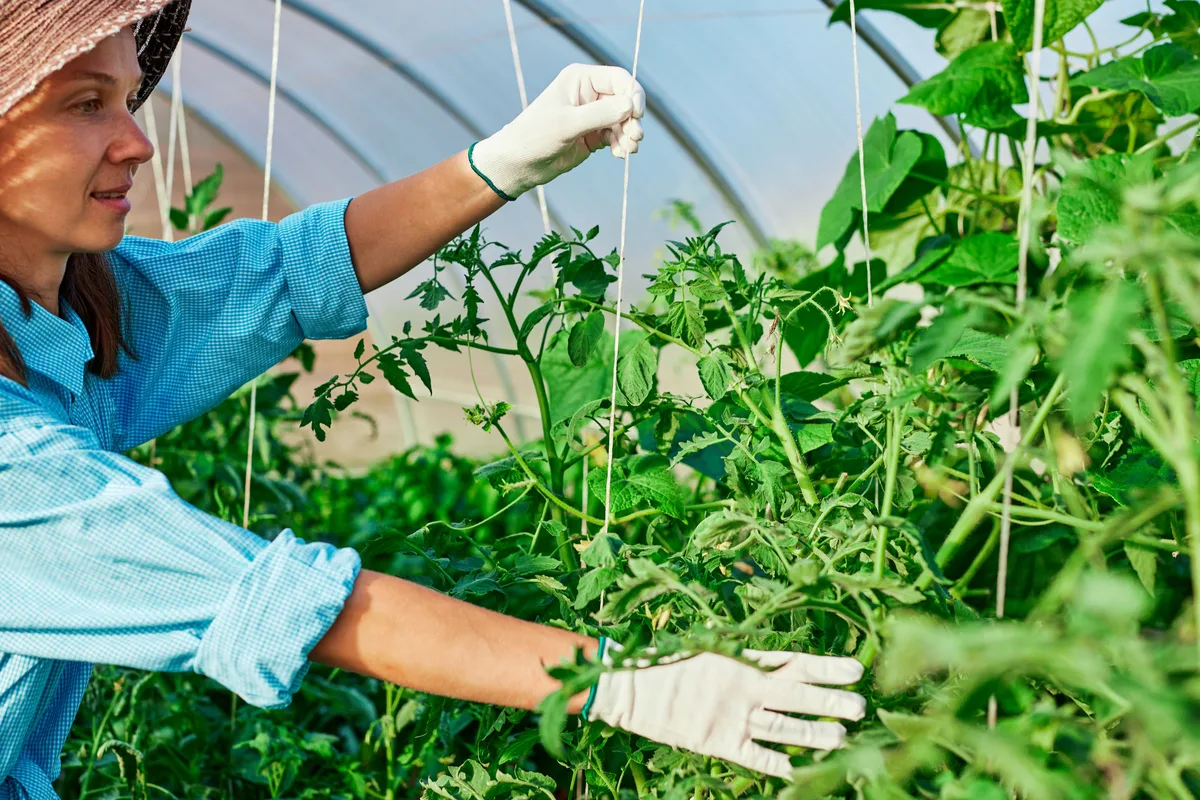
The two types of tomatoes – determinate (bush tomatoes) and indeterminate (vine tomatoes) both need staking, but for different reasons.
Let’s take a look.
Bush Tomatoes
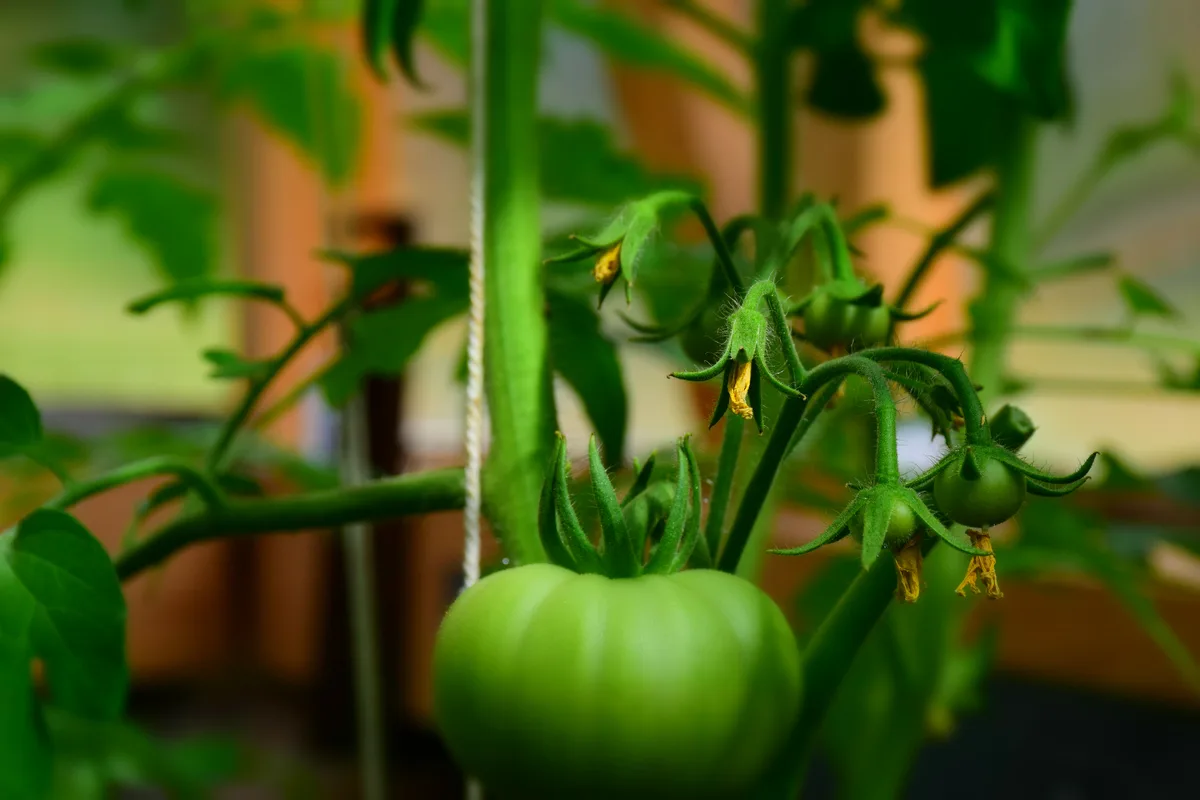
Determinate tomato varieties are the more compact bushy tomatoes. They grow around 2-3 feet for the dwarf varieties and up to 5 feet tall for others.
This type flowers at the same time, then sets fruit at the same time for a bumper quick harvest lasting about 2 weeks. They are prolific fruit producers, require less work than vine tomatoes and are perfect for small areas and containers for patios and balconies.
The recommended supports for these are:
Metal Cages
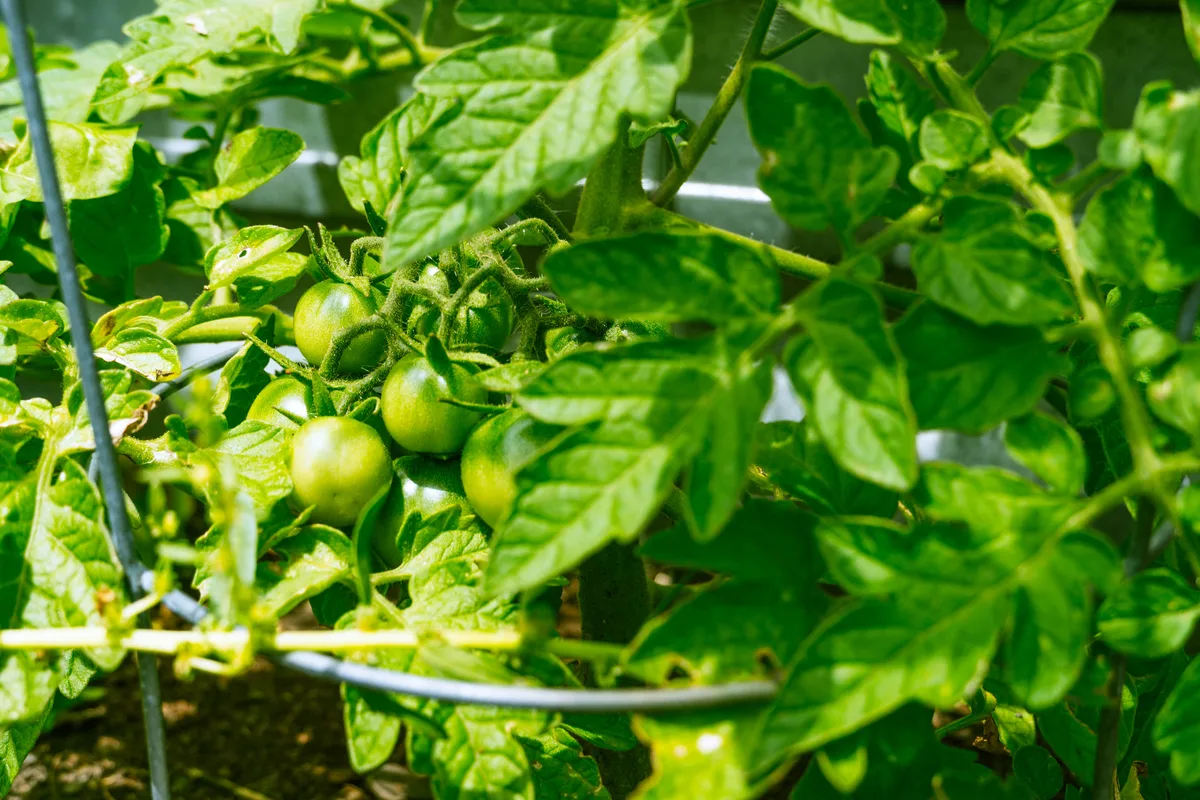
One of the easiest ways to support bush tomatoes is to use galvanized metal cages. These are set into the ground around each seedling when they are about 3 – 10 inches tall or when they have just been planted.
These cages are usually made up of 4 legs with 3 circular rings of wire welded to the legs to make a cage. They are easy to stack and store to bring out for the next season.
Simply press the legs into the ground around the seedlings. There is not much to do after that as the plants don’t need tying to the structure. It will have enough support to hold the heavy fruit when they start to form, just by resting on the sides of the cage.
Invest in heavy-duty metal cages rather than the cheaper flimsy ones as they may not be able to hold the weight of the tomatoes.
Square Mesh Netting
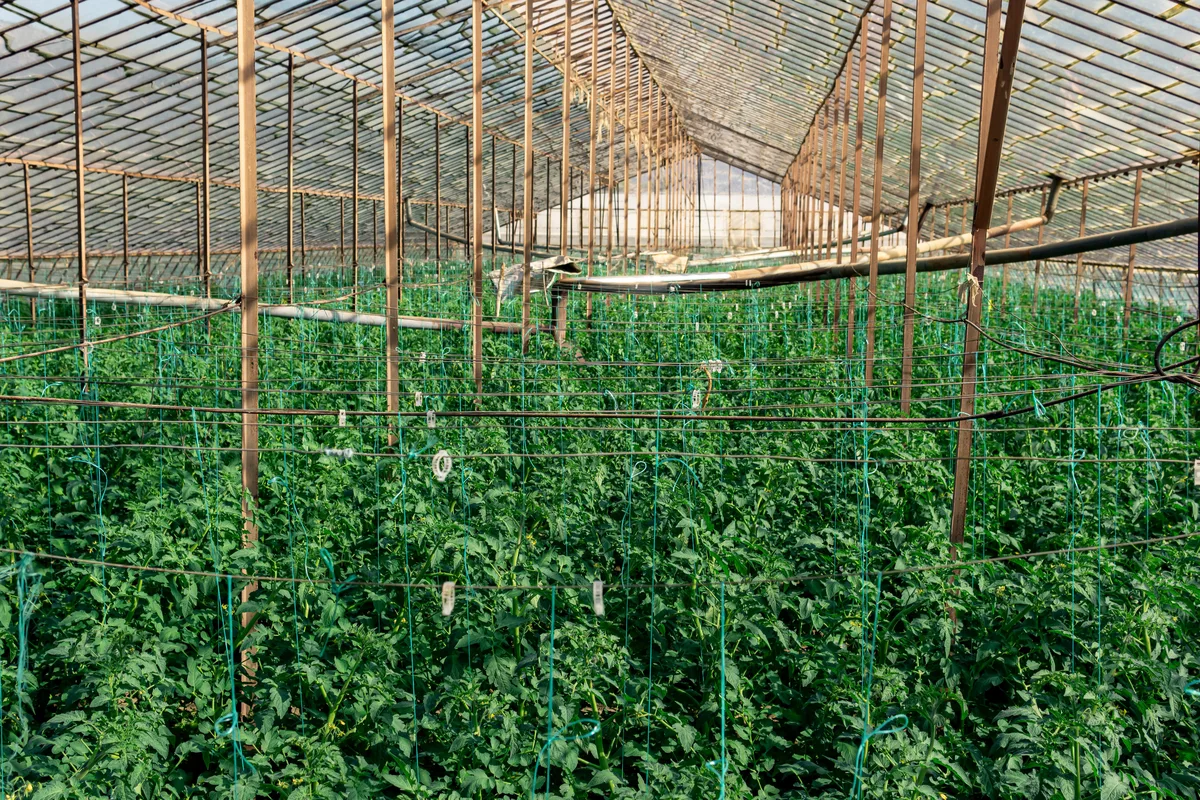
Square mesh netting is usually made from polypropylene and designed specifically for the horticultural industry to provide strong support for plants. The netting comes as a standard size but can be cut to fit any situation. Some places may also sell it on the roll by the yard.
This type of system is easier to use if the tomatoes are planted in rows. Place two stakes on either side of the growing area and two more supporting stakes on the other side. Depending on the length, add more supporting poles every 12 feet along the length of the growing area.
Tie the netting horizontally over the top of the plants, 1 foot above the ground. Tie it to the supports until it’s secure.
If the tomato varieties are going to be growing up to 5 feet and over, put in another layer of netting about a foot above the first layer. More layers can be stacked in this way, reaching the top of the main supports. Once the system is in place, the tomatoes will grow through the netting and get enough support without having to tie them.
Vine Tomatoes
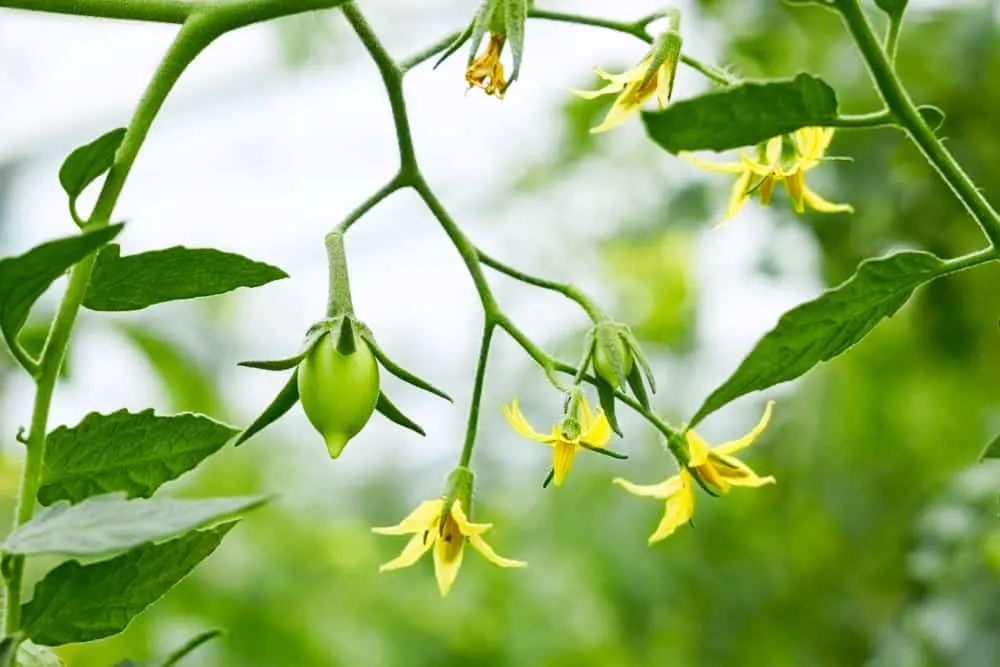
Indeterminate tomatoes all need staking to avoid diseases and keep the tomatoes off the ground. They differ from the determinate varieties in that they have a long growing season, with vines producing fruit on an ongoing basis until a hard frost ends the season.
You may get more out of these types of tomatoes, but they also require extra work and continual staking and tying to keep them in check. They will generally grow around 6-10 feet. Some of the cherry tomatoes can grow 14 – 16 feet in ideal conditions.
The recommended supports for these are:
Single Stakes
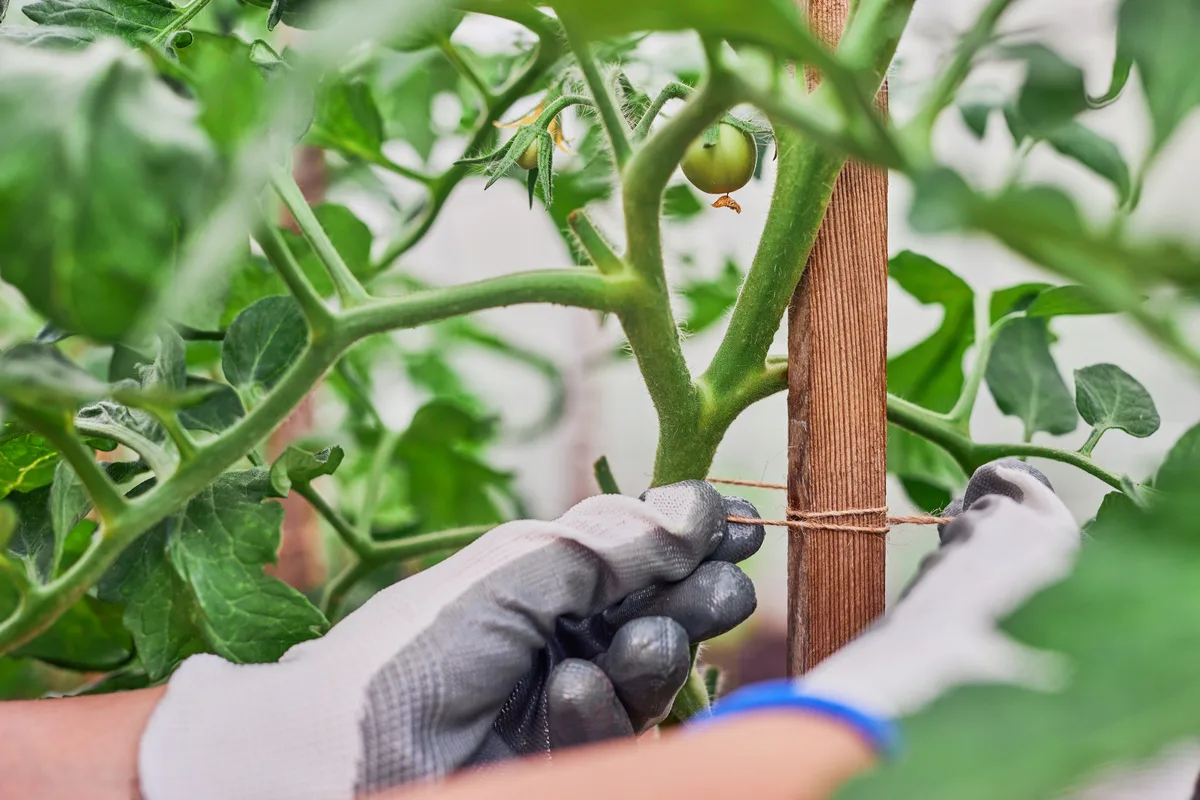
By going with a single stake per plant, the tomatoes do not have to be in a group or line and can be anywhere in the garden. Stakes can be made of wood, bamboo, plastic, metal and plastic-covered metal.
Stakes should be at least 7 feet tall (taller if possible). Hammer several inches of the base into the ground so that it’s sturdy and strong enough to carry the weight of the tomatoes.
The best way to stake it is to stake first and then plant. If the plants are already in place, the stake should be about 5 inches from the plants so as not to disturb the roots.
Use garden ties or strips of fabric to lightly tie the stems of the tomatoes to the stake. Be very careful as they are delicate and can snap off.
Square Mesh Netting
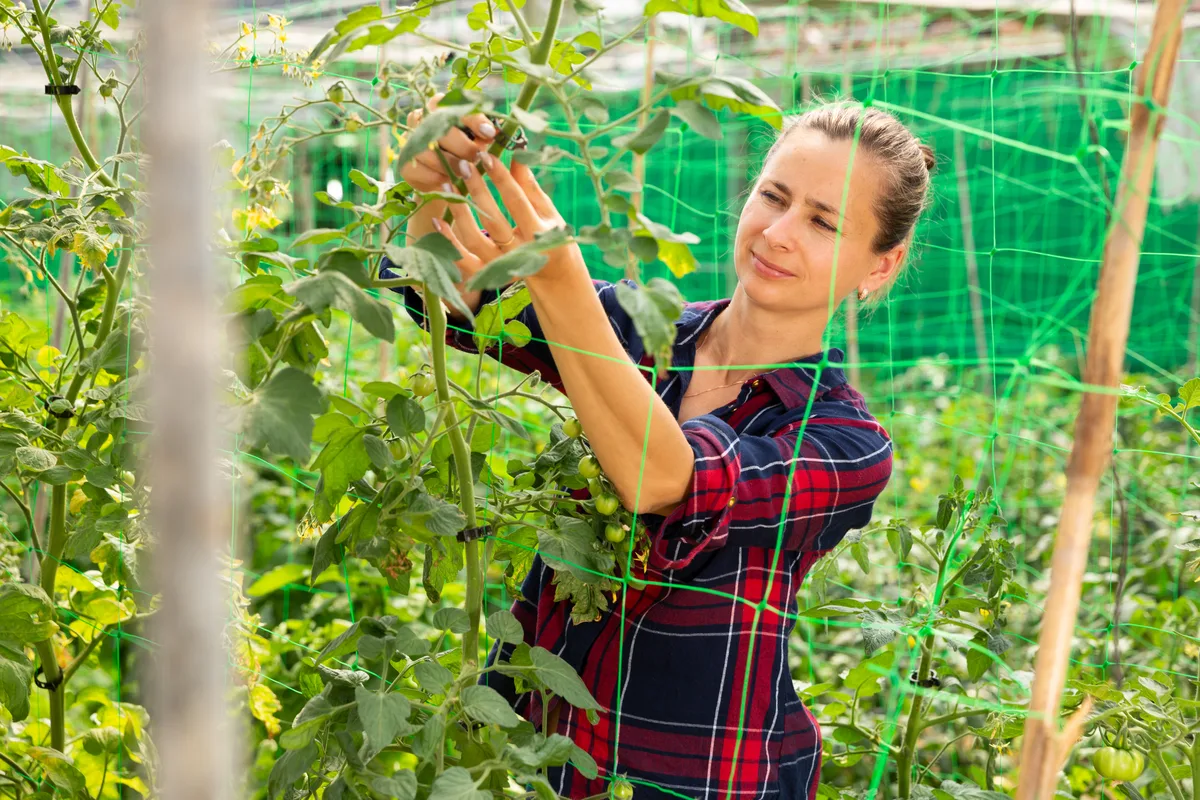
Just like the horizontal system, this product can be set up supported by string poles at either end of a line of plants and with supporting poles every 12 feet or so. The wooden poles must be set securely in the ground and have a width that is large enough to carry a sizeable load.
This setup is also best for plants that are planted together in a row. Tie the netting to the pole vertically and stretch across to the end of the line. Start the netting a foot above the plants and finish at the top of the poles. The height of the poles will be dependent on the variety of tomatoes and how much they are predicted to grow.
Florida Weave
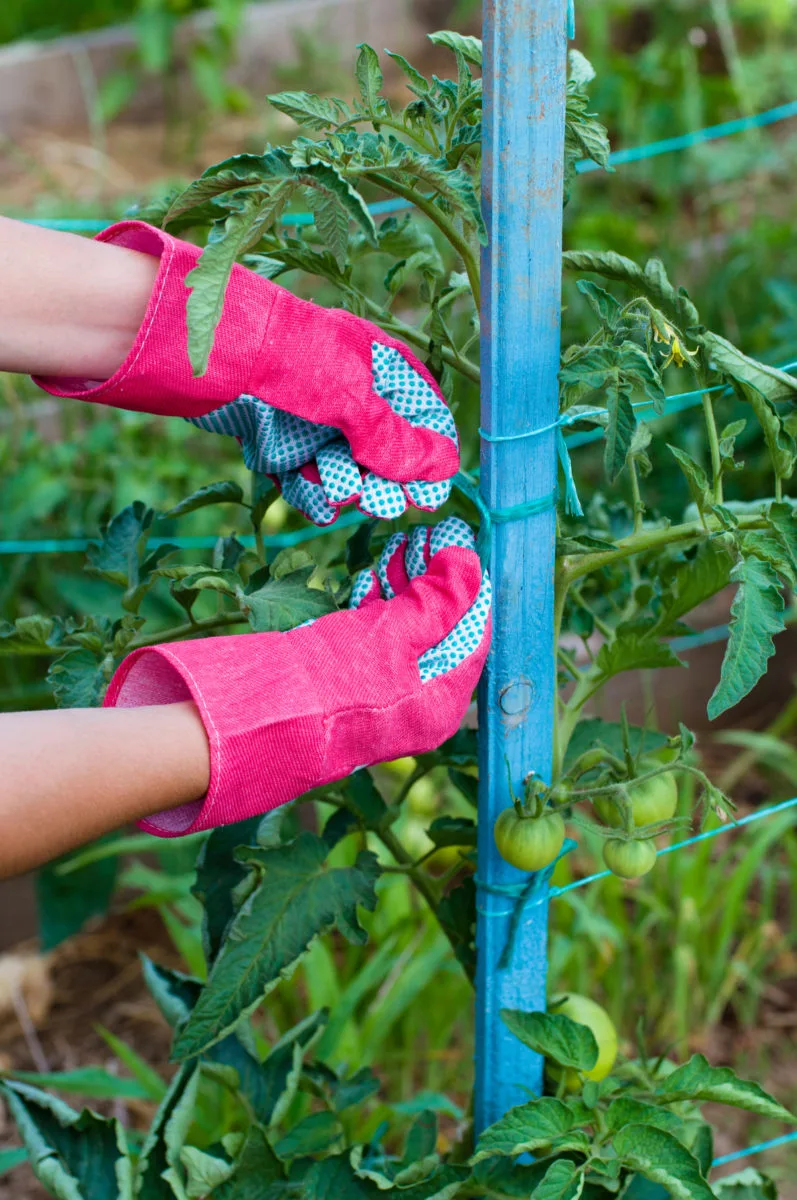
This popular choice is great for those growing many tomato plants at once. Secure a sturdy metal or wooden post into the ground at the ends of each row of tomatoes. Add wooden posts every 4-5 feet between the two anchor posts.
Plant the tomato plants every 2 feet along this line. Tie garden or cotton twine to the end post and then weave the twine between the plants to the other end. Then, come back over the same line weaving the twine in the opposite direction, forming a pocket that will keep the vines straight. As the plant grows, add more weaves moving upwards.
Trellis or Fencing
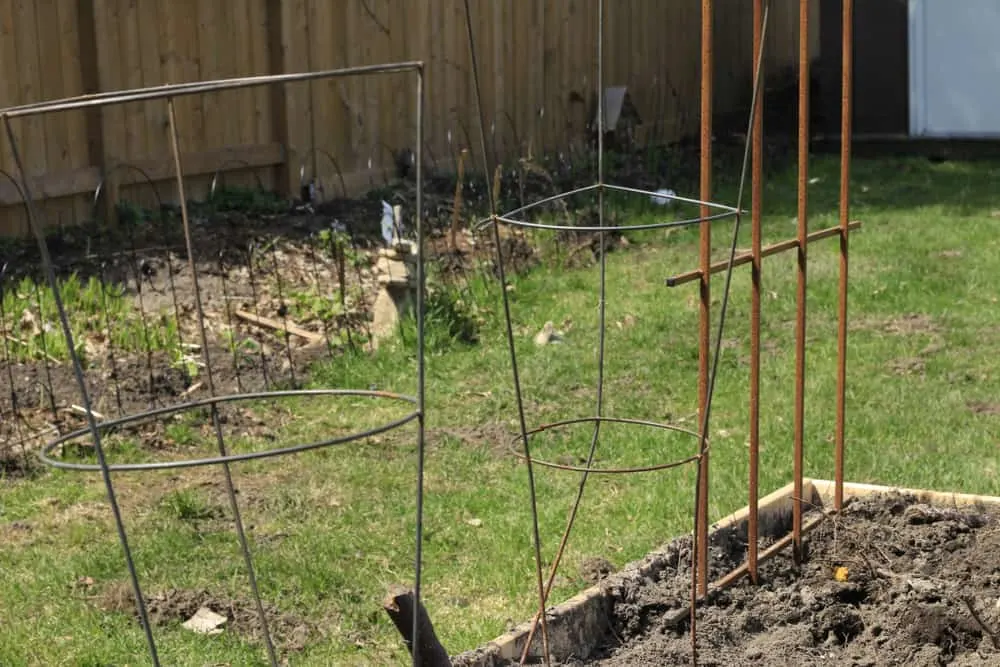
One of the easiest ways to support tomatoes is to plant them next to an existing fence and simply tie them up as the plants grow. Open wire fencing is ideal as it provides more airflow around the plants which tomatoes need to keep healthy. A solid wall or fence can be made into a support structure by simply adding some supporting wires a few inches away from the structure.
A wooden trellis can also be used as a quick and easy staking method. They come in a variety of panel sizes to suit the space available and the number of plants growing. They can also be added to large containers for single plants.
Trellis panels can be simply placed against a wall or fence with a few pins securing them to the ground. Or, they can be made freestanding with metal poles or rods hammered into the ground as supports. The trellis can be zip-tied to the structure and taken down easily enough when the plants are out of season.
How To Properly Tie Tomatoes
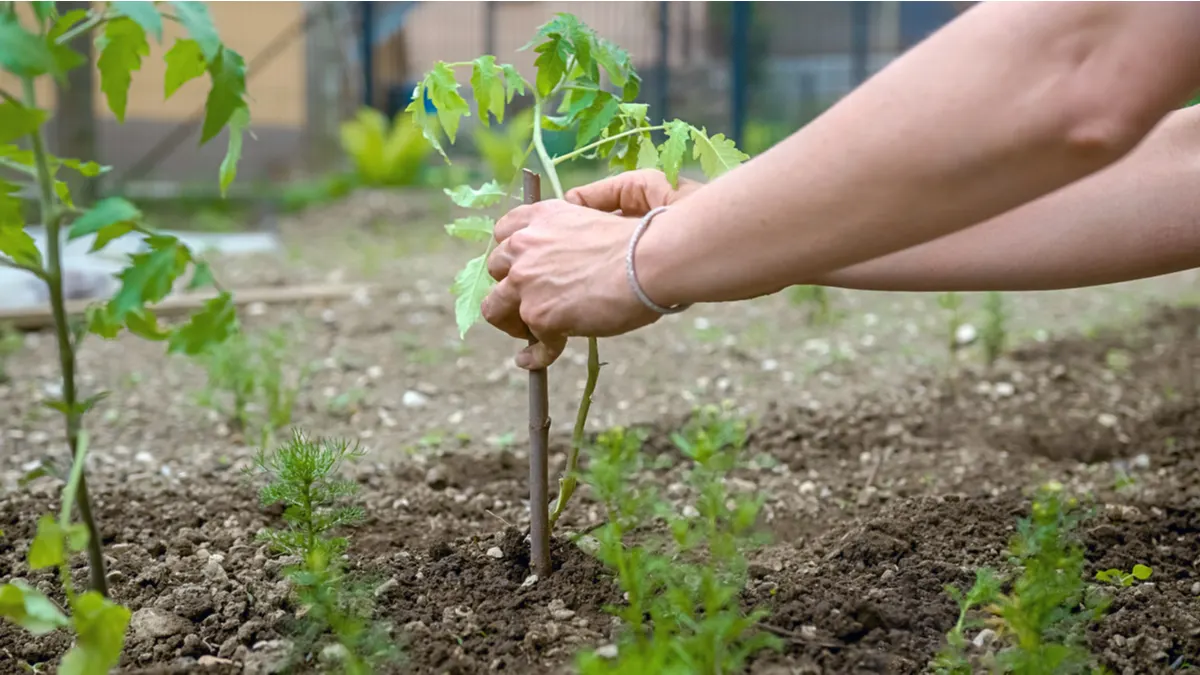
Now that you know what to use, the question is how. The easiest of these support methods doesn’t require any tying, allowing your plants to simply grow through the supports. However, if you’re using a method that does require tying, here’s how to do it.
The first method involves securing the stem of the tomato to the stake. First, tie a double knot to the stake. Then, choose a stem just below a branch for added support and tie a loose double knot around the stem.
Tie like this every 10 inches all the way up the stem and carry on tying as the plant grows. Check the lower stems and if they are too heavy for the plant to support, tie branches loosely to the stake as well.
For plants larger than 3 feet tall, you can choose to tie them up with one piece of garden twine or tape. Start at the base of the plant and circle the entire plant moving upwards. Start with a double tie to the stake and finish with the same, choosing strong stems to circle as you move up.
Tie Materials
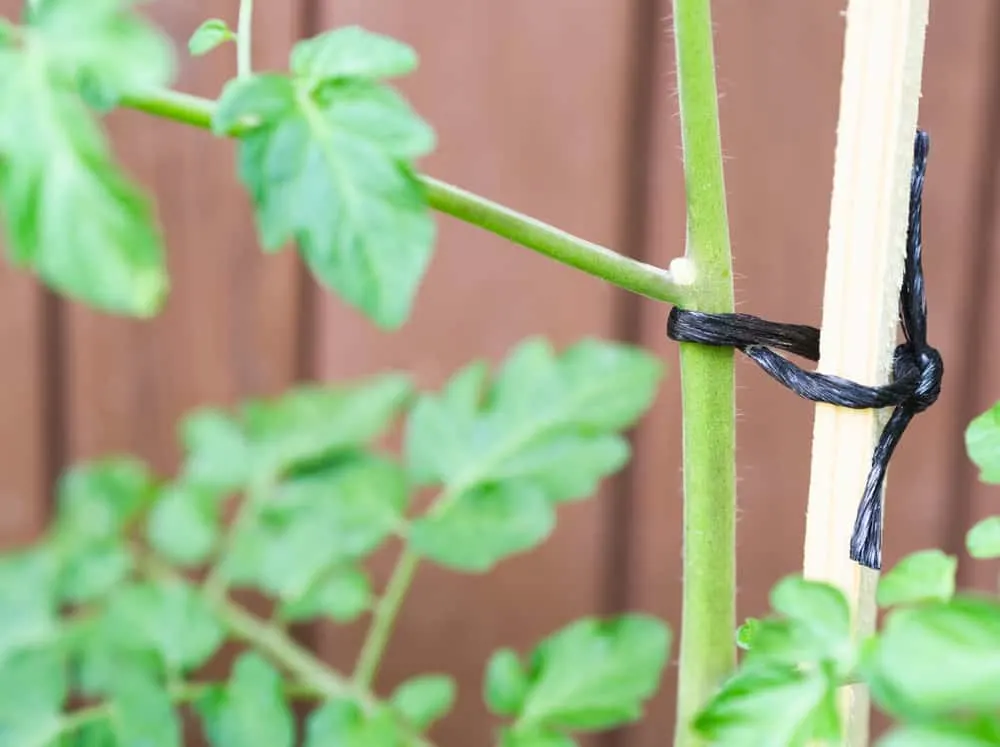
While it may seem insignificant, the material you use to tie your tomatoes up can have a big impact on how they grow.
If your ties are too stiff, they can cut into the stem, damaging the plant and making it more vulnerable to pests and disease damage. If they are too loose or thin, a strong breeze or stem with some extra weight can simply snap them.
These materials are the most commonly used and, if tied correctly (not too tightly) won’t damage your plants:
- Fabric. This material is stretchy, allowing movement of the branches without being restricted. Use any type of fabric cut into strips – the stretchy types are better like old T-shirts or lycra.
- Garden twine, available to buy from a nursery or hardware store and manufactured specifically for tying up plants. Cotton, sisal and hemp twine are also good choices as they are compostable at the end of the season.
- Compostable garden tape is perfect for the season and gentle on the plants.
These are the materials to avoid:
- Uncoated wire. Garden twine often has a plastic coating which makes it easy to manipulate yet soft on the plants. It can also be unwound and rewound often. Uncoated wire will cut into plants and a small bit of wind will break the stems.
- Nylon or foam ties can be used but must be collected at the end of the season because it takes decades to break down in a compost heap. These also include zip ties that are quick and easy to use, but not good for the environment.
- Fishing line is not good for plants as it can cut them and make marks for disease to thrive. It’s also a hazard to wildlife.
3 Mistakes To Avoid
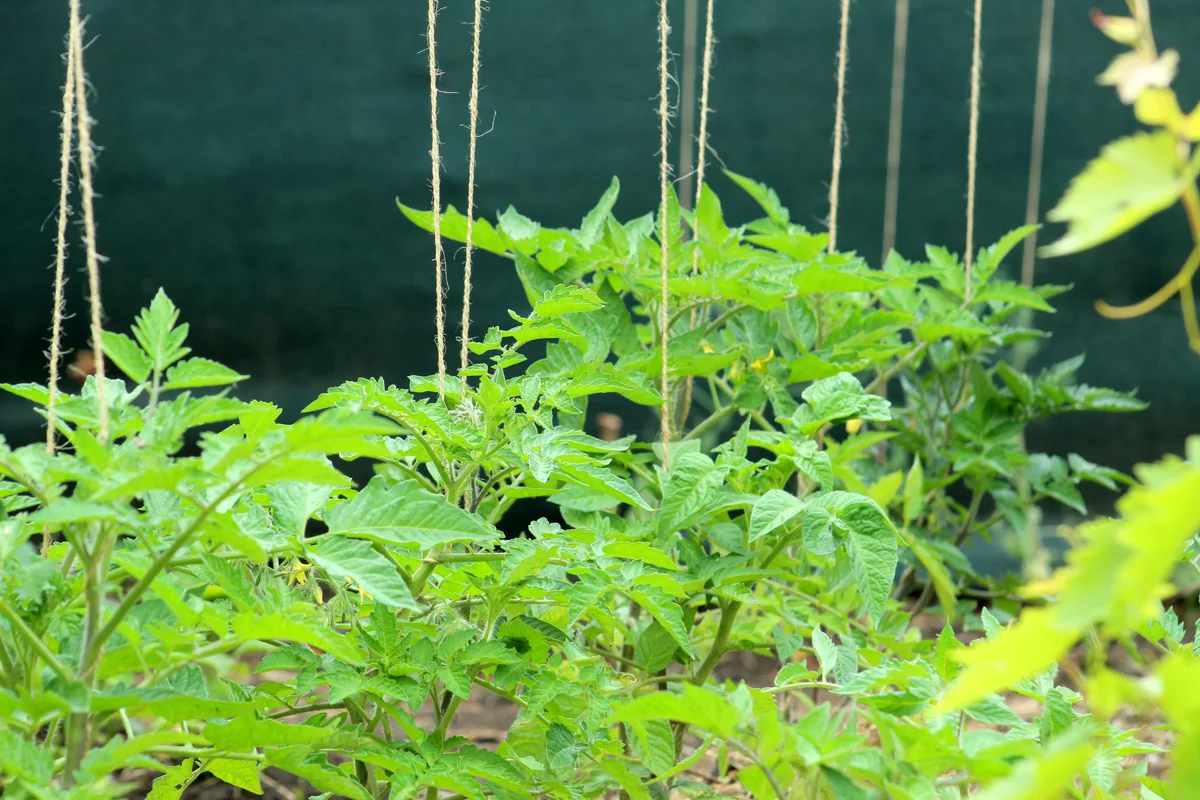
Even though the process of tying up tomato plants is simple, there are still some essential mistakes to look out for.
Firstly, make sure you place your support either before or at the time of planting. Trying to add supports too long after the plants are in and have been growing for a while may damage the roots of the plants.
Secondly, smokers can affect tomato plants by touching the stems when tying them to stakes. Tomatoes don’t like nicotine and areas touched may become sites for infection by fungi and viruses. Make sure to wash hands with soap and water well before tying up tomatoes.
And finally, tying the plants too tightly to the stakes or structure will damage the stems. This can lead to diseases and will make the flow of nutrients to the top of the plant strangled, resulting in poor growth and even dead sections of plants.
Follow the easy steps, avoid these common mistakes and you should have no trouble growing your tomatoes this season.
